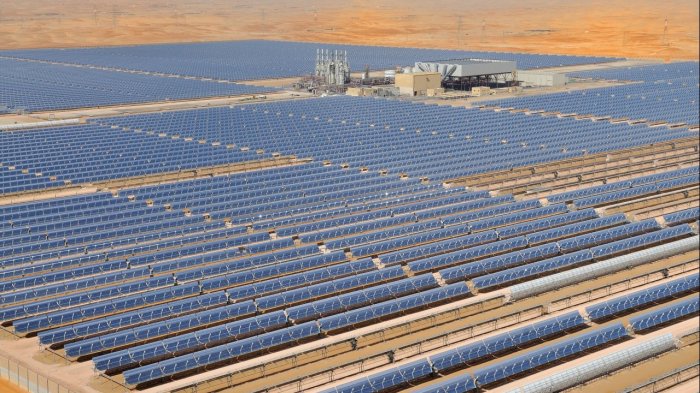 It would seem like an obvious idea. The planet needs to wean itself off fossil fuels, so why haven’t we built solar power plants in the deserts, to give us the energy we need? After all, in just six daylight hours, the Earth’s deserts soak up more energy than the entire planet uses in a year. And we’re not exactly short of desert around here.
It would seem like an obvious idea. The planet needs to wean itself off fossil fuels, so why haven’t we built solar power plants in the deserts, to give us the energy we need? After all, in just six daylight hours, the Earth’s deserts soak up more energy than the entire planet uses in a year. And we’re not exactly short of desert around here.
But while it seems strange that solar power is still not a major source of energy in this region, significant moves are being made to introduce it — the recent opening of Masdar’s Shams 1 (pictured above) being the biggest move so far. The solar plant in the Western Region of the UAE, with rows of parabolic (bowl-shaped ) mirrors, covers an area the size of 285 football pitches and has been adding electricity to the grid since January of this year.
Even though OPEC estimate that the UAE has proven reserves of 97.8 billion barrels — the seventh largest of any country — it was decided in 2006 to explore supplementary alternatives. Dr Sultan Al Jaber – CEO of Masdar tells us, “We needed to capitalise on our energy expertise and substantial financial resources to extend our reach in the global
energy markets and extend the lifetime of our hydro-carbon resources by pursuing renewable energy projects.”
Shams 1 is the largest concentrated solar power plant in the world and can power 20,000 homes but its output is small in comparison to traditional sources. While it creates a modest 100 megawatts from solar, the plan is to expand the site to generate 1,400 megawatts by 2020 — around seven percent of the UAE’s needs.
One of the reasons the introduction of solar has taken so long is cost. The $600million spent on this project is clearly not cost effective now (although a lot of that money went on getting things up and running), but as the plant expands and technology advances, the cost will reduce. “Solar power needs to be scaled up to bring down the cost and increase efficiency, and for that we need more projects and investment,” Dr Al Jaber explains.
According to Bloomberg, electricity produced by even the cheapest solar technology still works out at $160 per megawatt hour (MWh), compared with just $60 per MWh for electricity produced by coal-fired power stations, and $80 per MWh for the most efficient gas-fired power stations.
Significantly though, France’s Total and Spain’s Abengoa Solar each own 20 percent of the Shams 1 project, so traditional energy producers are investing. As Dr Al Jaber points out, “They know that renewable energy sources are the only sources of energy that will grow over time, while hydrocarbons will decrease.” There are other economic incentives to invest: as oil reserves diminish, the oil price will rise. Going solar will leave more of the increasingly profitable oil to export. That solar power is also being exported now.
“We in the UAE are integrated through a network with the rest of the GCC and the power we produce is all connected to the grid, so yes, some is being exported,” Dr Al Jabbar explains. “At the same time, Masdar has built solar power plants outside of the country [in Spain], and so we already exporting green power through our investments and projects.”
Elsewhere, developments are also in place with Desertec , a European network of scientists and engineers. It points out that just one percent of the surface area of the world’s deserts could generate as much electricity as the world is now using . They are working on projects that will help scale-up technology and bring down the price globally. Smaller projects also exist. According to National Geographic, Germany is currently the world leader, with a cumulative 17,192 megawatts installed by the end of 2010. Spain is second, with 3,784 megawatts.
Dr Al Jaber asserts that, for the moment, they’re not thinking about how long it will take until renewable energy is a primary power source — they’re merely looking to complement existing hydrocarbon fuel. But the growth in solar power in this part of the world is significantly emanating from what Masdar has already set up.
As Dr Al Jaber points out, “Saudi Arabia, Qatar and Kuwait are all looking to pursue renewable energy, and that paradigm shift created by Masdar is what has motivated our neighbouring countries to start seriously exploring renewable energy.” In 1973 the Saudi oil minister Sheikh Ahmed Zaki Yamani famously said, “The Stone Age didn’t end because we ran out of stones.” And there are still those who believe that the oil age will not end because we’ve run out of oil, but rather because we find workable alternatives.
The need to find those alternatives is increasingly pressing as the world faces climate change and a growing population. A serious move towards solar has begun. Notably, right here.
For Esquire Magazine – click here for PDF – Exit Notes_solar


